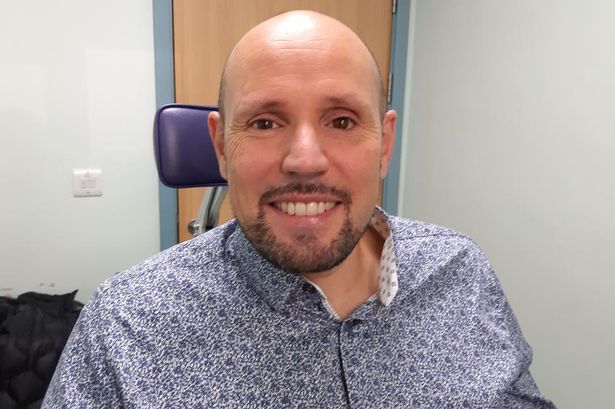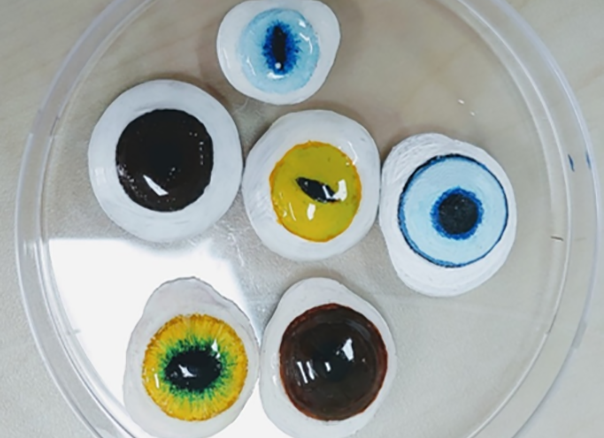A London man has reportedly become the first person in the world to be fitted with a 3D printed prosthetic eye.
Steve Verze received the eye today at Moorfields Eye Hospital in Finsbury, London, which provides a more realistic look than a traditional acrylic prosthetic eye and can be manufactured in a much shorter time frame.
Professor Mandeep Sagoo, Consultant Ophthalmologist at Moorfields Eye Hospital, hopes the forthcoming clinical trial of the 3D printed prosthetic eye will provide the team with “robust evidence” of the value of the technology, and says it has the potential to reduce waiting lists.

Optical 3D printing
Moorfields Eye Hospital is claiming the delivery of the 3D printed prosthetic eye as a world first, and while this does appear to be the case there has been some previous research in the area of optical prosthetics and grafts.
Design agency Fripp Design has been developing 3D printed artificial eyes for a number of years in partnership with Manchester Metropolitan University and the University of Sheffield. In the past, the company has claimed to be able to produce over 120 eyes in an hour with its patented process.
However, last year owner Steve Roberts announced his intention to sell the company’s 3D printing silicone IP in order to pursue other ambitions. Whether the development of the 3D printed eye prosthetics continues remains to be seen.
In 2018, the Severance Hospital of the Yonsei University Health System (YUHS) announced plans to commercialize its first 3D printed artificial eye, as part of a research project sponsored by the Korean Ministry of Science and ICT. The prototypes were slated to be ready by 2020, however the hospital has not yet provided an update on their progress.
Elsewhere, 3D printing has previously been deployed to help reconstruct the eye of a 47-year-old woman. The woman’s face was captured using 3D scanning and CAD modeling techniques to give a customized eye model which was then 3D printed via SLA to form a mold to make the artificial eye.
While fully 3D printed eye prosthetics may be a first for humans, man’s best friend has already benefited from the technology. Last year, researchers from Chungbuk National University developed low-cost personalized artificial eyes for canines that had lost theirs to incurable diseases. The 3D printed prosthetics were successfully tested on two beagles and considered to have “great potential” in veterinary applications.

The 3D printed prosthetic eye
Manufacturing on Demand
Today appears to mark the first time a 3D printed prosthetic eye has been cleared for human use as part of a clinical trial.
Currently, being fitted with a traditional acrylic artificial eye is a long and drawn-out process, with patients having to undergo a two-hour session to mold their eye socket, before the prothesis is fitted and then painted. In total, the process can take around six weeks.
According to Moorfields, 3D printing offers a much faster alternative, reducing the manufacturing process to just two to three weeks. The initial appointment to measure the eye socket is also shortened to just half an hour.
Ocupeye and Fraunhofer IGD lent their software expertise to the project, which is supported by the National Institute for Health Research, the Moorfields Biomedical Research Centre, and Moorfields Eye Charity. Once Verze’s eye socket had been scanned and the data modeled, the customized eye prosthetic was printed by German 3D printing service bureau FIT AG.
The hospital also believes the 3D printed prosthetic eye is more realistic looking than a traditional acrylic one, due to the way light is able to travel through the full depth of the printed eye. This sentiment is echoed by Verze, who has always “felt self-conscious” about his artificial prosthetic.
“This new eye looks fantastic and, being based on 3D digital printing technology, it’s only going to be better and better,” he said.
Sagoo and his team at Moorfields Eye Hospital are optimistic about the forthcoming clinical trial, and believe the technology has the potential to significantly reduce waiting lists for patients needing eye prosthetics.
* This article is reprinted from 3D Printing Industry. If you are involved in infringement, please contact us to delete it.
Author: Hayley Everett

Leave A Comment